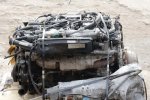pcatterall
Well-known member
I say experts because I fell it may benefit all of us with no knowledge or whose knowledge is sketchy to understand this fitting and some issues around it.
As some of you will know some of us are trying to reduce engine noise by fitting air inlet silencers ( which have been found to give significant noise reduction)
One issue concerns the connection of the chosen silencer box to the little hose that goes to the rocker.
My ( sketchy) understanding is that oil/vapour can leak from worn valves into the rocker box and the oil needs to be drained and any pressure released.
The little hose does this job by draining/forcing ( there may be an element of venture suction as well) the oil into the silencer box.
With diesels it is important, however, that significant oil is not allowed to enter the engine or the engine may start to burn this oil and be difficult to stop.
As stated my knowledge is very limited and a concise explanation would be very useful to me and ( I think many others).
In my case I want to mount my box some way from the engine intake and would have to fit a very long hose from the rocker box to the silencer box.
I understand that I could optionally fit a container near the rocker box and just allow any oil to drain into that?
I have also looked at these 'universal filter' kits which are essentially just a filter and hose ( sold mainly in pretty colours to car modifiers!) I thought these would be easy fit and may reduce the noise but see that the rocker box hose goes into the main air intake pipe AFTER the filter raising the prospect of oil being drawn into the engine.
So can some kind and knowledgeable person explain this little system to me and others who will find it interesting and useful?
Many thanks
As some of you will know some of us are trying to reduce engine noise by fitting air inlet silencers ( which have been found to give significant noise reduction)
One issue concerns the connection of the chosen silencer box to the little hose that goes to the rocker.
My ( sketchy) understanding is that oil/vapour can leak from worn valves into the rocker box and the oil needs to be drained and any pressure released.
The little hose does this job by draining/forcing ( there may be an element of venture suction as well) the oil into the silencer box.
With diesels it is important, however, that significant oil is not allowed to enter the engine or the engine may start to burn this oil and be difficult to stop.
As stated my knowledge is very limited and a concise explanation would be very useful to me and ( I think many others).
In my case I want to mount my box some way from the engine intake and would have to fit a very long hose from the rocker box to the silencer box.
I understand that I could optionally fit a container near the rocker box and just allow any oil to drain into that?
I have also looked at these 'universal filter' kits which are essentially just a filter and hose ( sold mainly in pretty colours to car modifiers!) I thought these would be easy fit and may reduce the noise but see that the rocker box hose goes into the main air intake pipe AFTER the filter raising the prospect of oil being drawn into the engine.
So can some kind and knowledgeable person explain this little system to me and others who will find it interesting and useful?
Many thanks

